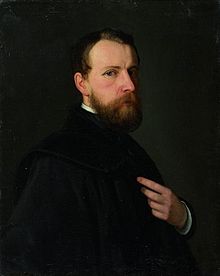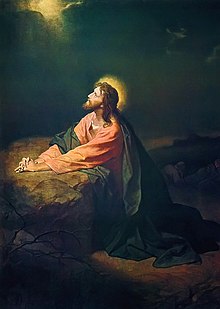Heinrich Ferdinand Hofmann
Heinrich Johann Michael Ferdinand Hofmann (born March 19, 1824 in Darmstadt , † June 23, 1911 in Dresden ) was a German painter and illustrator.
Life
Heinrich Hofmann grew up in a family that was very interested in art. His father, the publicist and court attorney Heinrich Karl Hofmann (1795–1845), painted watercolors, his mother Sophie Hofmann, b. Volhard (1798–1854) gave art lessons before their marriage and his four brothers were all artistically gifted. Besides his brother Rudolf , Heinrich was the only one who made painting his profession. He was the uncle of Ludwig von Hofmann .
Hofmann received his first art lessons from the court engraver Ernst Rauch in Darmstadt. In 1842 he moved to the Düsseldorf Art Academy , where he joined Theodor Hildebrandt's painting class . He was later accepted into Wilhelm von Schadow's studio, where he created his first major work, a scene from the story of the Lombard king Alboin .
Study trips to Holland and France followed. In 1846 Hofmann attended the art academy in Antwerp. After a long stay in Munich, he returned to Darmstadt in 1848 and began an intensive phase of portrait painting. His family's political activities gave him access to influential people. During this time, two portraits of Heinrich von Gagern and one of Justus von Liebig were created (the portrait of Justus von Liebig is in the possession of the Queen of England ). In 1851 Hofmann traveled to Dresden with the aim of studying the picture gallery. In 1853 he went to Prague and painted the portrait of Dr. Beer, the Grand Master General of the Brotherhood of the Cross.
In 1853 Hofmann returned to Darmstadt and at the beginning of 1854 his beloved mother died. Her death moved him deeply and inspired him to paint his first major work with a religious theme, the "Entombment of Christ".
In the autumn of 1854 he set out for Italy. The first long stay in Venice was used to study Giorgione , Bellini and Giotto (in nearby Padua). After a two-month stay in Florence, Hofmann traveled to Rome in January 1855. The intensive correspondence with his family and, above all, his detailed diary entries from this time give an insight into his artistic work. The works of art of antiquity, Christianity and the Renaissance made a deep impression on him.
Shortly after his arrival in Rome he was introduced to Peter by Cornelius and was a frequent guest there. When he began with the painting “The Capture of Christ” in 1854, this work aroused the interest of Cornelius, and he accompanied Hofmann with his advice for four years. In 1858 the picture was completed and bought by the grand ducal picture gallery in Darmstadt.
In 1858 Hofmann returned to Darmstadt and married Elisabeth Werner the following year. The marriage remained childless.
Another period of portrait painting followed; During this time he also created a large altarpiece for the church in Obermörlen (Hesse): “Madonna with the Christ Child and Paul and Peter”. A little later the altarpiece in the church in Væggerløse on Falster (Denmark): "Risen Christ".
In 1862 the Hofmann couple moved to Dresden. In 1870 Heinrich Hofmann was appointed to succeed Professor Johann Carl Baehr at the Dresden Art Academy, of which he was already an honorary member. In 1872 he was awarded the large gold medal by King John and later by King Albert of the Order of Albrecht . Hofmann's wife died in 1891, and soon afterwards he withdrew from the art academy into private life. From his letters it becomes clear that he still created numerous works until his death on June 23, 1911.
Four of Hofmann's best-known works are owned by Riverside Church in New York: "Christ and the Rich Young Man", "Christ in Gethsemane", "The Boy Jesus in the Temple" and "Image of Christ". According to the Riverside Church, the painting "Christ in Gethsemane" is probably the most copied painting in the world.
Hofmann's religious works have become increasingly popular again in recent years. The publication of his paintings and pencil drawings on the life of Jesus in the Bible interpretation "The Second Coming of Christ" by the Indian philosopher and yoga teacher Paramahansa Yogananda contributed to this.
Works (selection)
Heinrich Hofmann was one of the most important painters of his generation. In “The Sunday Strand” - a magazine that was widespread in England at the time - he is described as the most influential contemporary German painter. Hofmann's painting style was primarily based on old German and old Dutch art and the Italian masters. During his stay in Rome he also got closer to the Nazarenes , especially through the influence of Cornelius; nevertheless he remained true to the Renaissance models throughout his life. Religious themes are at the center of Hofmann's artistic work. However, he also created numerous portraits and pictures with mythological and historical representations.
painting
- King Alboin , 1845
- Heinrich von Gagern , 2 portraits, 1848
- Peter von Cornelius , portrait, around 1850, Mathildenhöhe Institute, Darmstadt
- Self-portrait , Mathildenhöhe Institute, Darmstadt
- The sculptor Ernst Hähnel , 1852, Gemäldegalerie Neue Meister, Dresden
- The Capture of Christ , 1858, Hessisches Landesmuseum Darmstadt
- Altarpiece for church in Obermörlen (Hesse), 1860
- Altarpiece for the church in Vaeggerlose , (Denmark), 1867
- The adulteress before Christ , 1868, Dresden, Gemäldegalerie Neue Meister
- Christ preaches on the Sea of Galilee , 1875, National Gallery Berlin, loan to the regional church office in Kassel, destroyed in World War II
- Engagement of Prince Albrecht von Wettin to Zedena v. Bohemia , mural, 1878, Albrechtsburg, Meißen
- Large ceiling painting in the court theater in Dresden: Apotheosis of the Heroes of the Greek Drama , 1876
- The Jesusknabe in the Temple (original), 1881, Gemäldegalerie Neue Meister, Dresden
- The Baby Jesus in the Temple (copy, in Hofmann's studio, under his guidance and partly made by himself), 1882, Riverside Church, New York
- The twelve-year-old Jesus in the temple , (copy), 1884, Kunsthalle Hamburg
- Christ with Mary and Martha , 1888, private property, Los Angeles, USA
- Christ and the Rich Young Man , 1889, Riverside Church , New York
- Christ in Gethsemane , 1890, Riverside Church, New York
- Image of Christ, raising his left hand as if to bless , 1894, Riverside Church, New York
Art portfolios
- Remember my: A Christmas present for Christian families. 12 drawings from the life of the Savior. Munich: Ackermann 1886
- Come to me! Images from the life of the Savior; Festival for Christian families. Wroclaw 1887
- Peace be with you: pictures from the life of the Savior. Munich [u. a.]: Hanfstaengl 1898
Illustrations
- Shakespeare Gallery: Characters and scenes from Shakespeare's dramas. Drawn by Max Adamo, Heinrich Hofmann a. a. Thirty-six sheets in steel engraving, engraved by Bankel, Goldberg a. a. With an explanatory text by Friedrich Pecht. Leipzig: Brockhaus 1870.
- The New Testament of our Lord and Savior Jesus Christ. Based on D. Martin Luther's translation. With 15 full pictures in Lichtdr. v. Heinrich Hofmann. Leipzig: Hinrichs 1893
estate
Letters, diaries and notes from the Hofmann family estate are kept in the Hessian State Archives in Darmstadt .
literature
- Heinrich Ferdinand Hofmann . In: Hans Vollmer (Hrsg.): General lexicon of fine artists from antiquity to the present . Founded by Ulrich Thieme and Felix Becker . tape 17 : Heubel – Hubard . EA Seemann, Leipzig 1924, p. 260-261 .
- Saur bio-bibliographical index A - Z 1999–2000. Volume 5, p. 24.
- Friedrich v. Boetticher : painter works of the 19th century. Dresden 1895.
- Barbara Bott: Paintings by Hessian painters of the 19th century in the Hessian State Museum in Darmstadt. Inventory catalog. Heidelberg: Kehrer 2003 (catalogs of the Hessisches Landesmuseum 20) ISBN 3-926527-69-2 , ISBN 3-933257-67-0 .
Web links
- Rosemarie Müller: Heinrich Hofmann: Painter of Christ (English)
| personal data | |
|---|---|
| SURNAME | Hofmann, Heinrich Ferdinand |
| ALTERNATIVE NAMES | Hofmann, Heinrich Johann Michael Ferdinand (full name) |
| BRIEF DESCRIPTION | German painter and illustrator |
| DATE OF BIRTH | March 19, 1824 |
| PLACE OF BIRTH | Darmstadt |
| DATE OF DEATH | June 23, 1911 |
| Place of death | Dresden |

